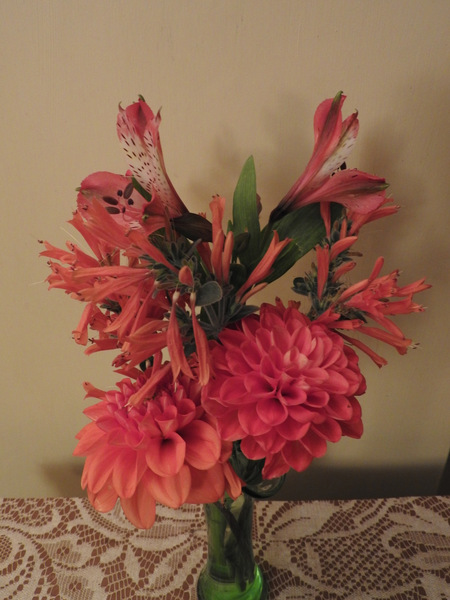The multi -hued colour palette of August
Sunday, September 4, 2016
August is often maligned as a difficult month in the garden,
when it takes a break before the blaze of early autumn and the slow
slide into winter. It can also be a very variable month
weatherwise, especially in West Wales.
Always a favourite border in the Paddock Garden at this
time of year, is the part shady border. Now at it's peak with the
blazing yellow of rudbeckia fulgida "Goldsturm" - 2 months of never
ending beauty.
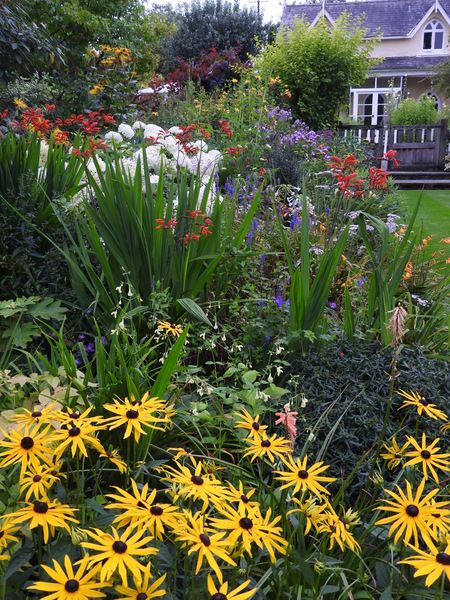
But travel just 200 miles to South east England as we did, and
it is a very different picture with consistently hot sunny weather
and drought like conditions.
The field car park at Hyde Hall with scarcely a trace of
any grass

On balance however, I don't think I would swap our mixed bag of
weather, because this year after a mild and very wet winter and a
cold spring, growth has been immense and many plants have continued
to flower well into August to join forces with the stalwarts of
late summer. Grass has remained green and the countryside all
around us looks contented, as do the livestock with plenty to graze
upon.
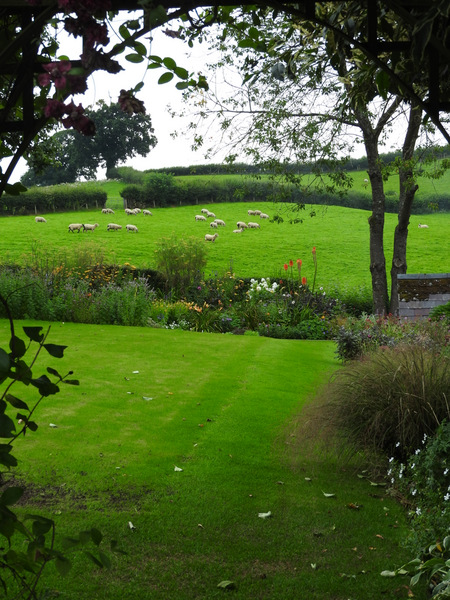
Just 6 miles away from us are the foothills of the
Brecon Beacons and the Carmarthenshire Fans
(mountains)
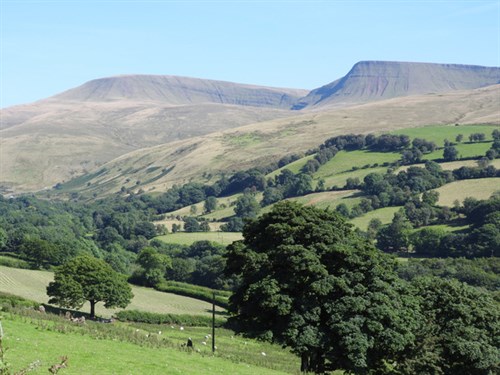
And to keep you reading until the end, what is this? In
the news during the early part of August
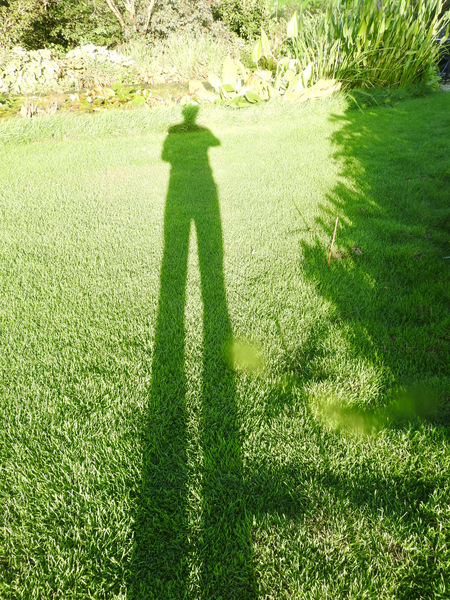
Weather
A very mixed bag but the dominant features were plenty of rain,
occasional very strong winds, some hot days and many mild nights.
Much better overall than last August which was predominantly cold
and wet with just 2 days over 21C and some nights as low as 5C.
This months figures Max 25C on 2 occasions and a further 16 days
over 21C. Just 2 nights below 10C lowest 7C on 9th.
On the only clear night during the phase of meteor
showers, I was out at 2.30 am to take some pics (am I nuts or
what?!!) but the showers failed to put in appearance so
the moon will have to do!


But every cloud has a silver lining!

Garden update
Most areas of the gardens look well with a good range of veggies
in quantity, which even with one less vegetable bed we are finding
it difficult to keep up with! Peas and broad beans were excellent
but are now finished, carrots still fly free and "Amsterdam" an
older variety keeping us well supplied with long finger like very
sweet carrots. Brassicas planted for succession continue to benefit
from application of Perlka that I wrote about at length last month.
Tomatoes have at last got into their stride with my 2 old
favourites "Gourmet" a standard size and the small plum
"Rosada" continuing to earn their place with intensely
flavoured well balanced taste. Grown in 15 litre deep pots filled
with equal amounts of sheep manure and top quality home made, loam
based growing medium, I rarely need to feed them.
Potatoes came to harvest earlier than I would have liked after
such a late planting, because of a sudden attack of blight at
the end of July and the attention of rats that required me to dig
them as quickly as possible!!
A meagre crop by my usual standards but with only half
the amount planted and very late I was quite pleased. Some choice
varieties - Venezia, Exquisa, Charlotte and Maris Peer to enjoy
well into autumn and early winter.
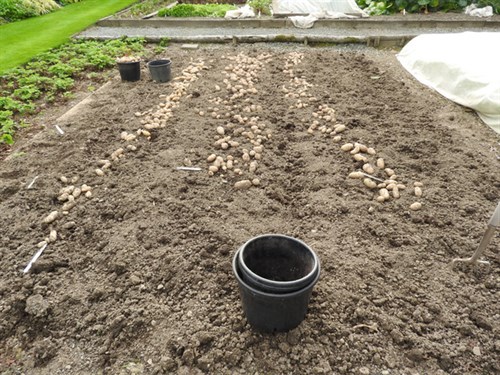
In the flower borders there has been so much to admire
individually and collectively that it is difficult to believe that
they have had far less attention than in previous years. It is
amazing how the perennials have kept going for so long, many of
them first plantings from 1999 onwards.
Clematis are notoriously slow to get going but once they
do as in c. "Flore Pleno", they pump up out late flowers from July
onwards, For me far suprior than the blowsy early large flowered
forms which always get wilt here. Reputedly introduced in the UK in
the 16thC.
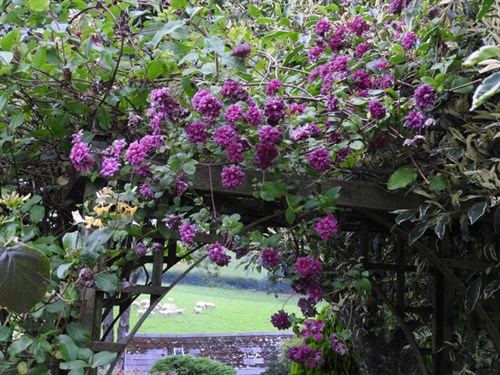
The large clumps of asters, phlox, the daisy tribe and some
impatiens to name just a few, should have been split may years ago
but as they are still in good condition I just let them get on with
it. Some of the shrubs which are at least 10 years older than
the perennials, are beginning to show their age especially the
elders, wiegelias and some viburnums. Others however continue to
thrive and give great delight, many having been planted as young
plants in 2 or 3 litre plants. I am so glad that I have been able
to see the mature specimens with my own future being so
uncertain.
The Red Border was planted between 1998 and 2000
and most of the original plantings are still going strong. Dahlias
are never dug up for winter here.
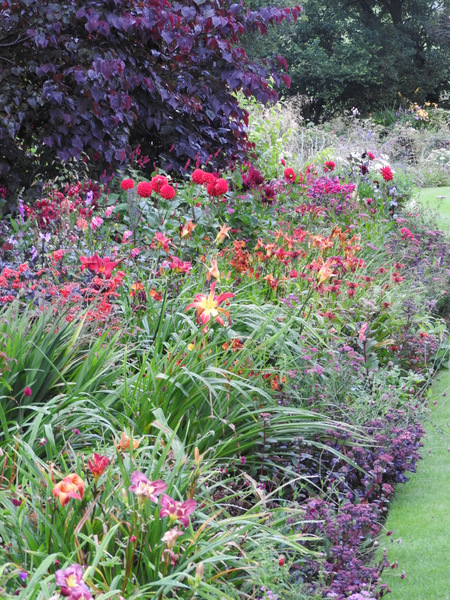
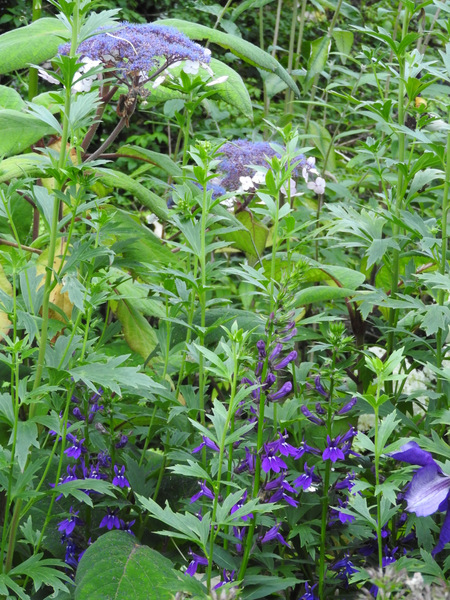
The Yellow Border in the House Garden is 15 years
old

Fuchsia "Lady Bacon" my favourite hardy fuchsia,
which benefitted from the mild winter and is flowering on old wood
to at least 4 feet tall and covered in flowers in part
shade.
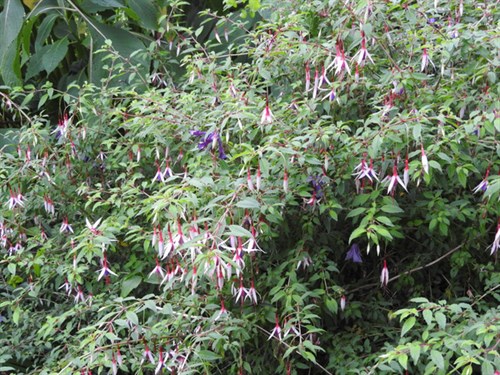
Not yet old enough to be considered mature at only 18
feet or so, but this purple leaved version of the Indian Bean Tree
flowered for the first time this year having been planted 10 years
ago.
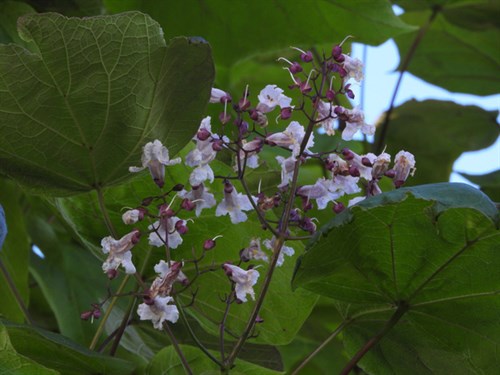
I am really pleased with how this planting
combination has worked out. Young plants over 10 years old, they
have all kept pace with each other and reached maturity at the same
time. From the left - phlox paniculata "Miss Pepper", the white
form of Veronicastrum and Hydrangea "Vanille Fraise" blending in
perfect harmony. The effect is enhanced by the dark
backround.
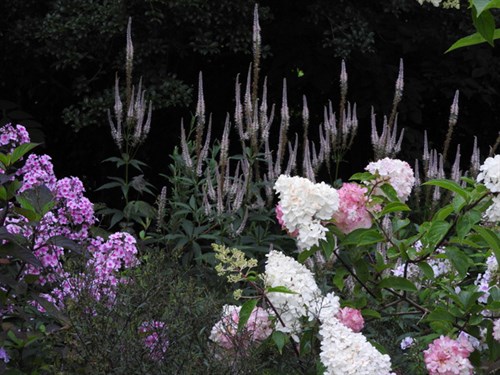

The only down side recently has been the first moles we have
ever had in the lawns. In the space of just 4 days an area of 10
sq, metres has been decimated with tunnels near the surface and the
customary molehills comprising only the finest soil!!. I called in
a "mole man" straight away who told me that they are a particular
problem this year as our ground is so wet that most of the worms
their main prey, are on the surface so the moles don't have to dig
so deeply.
What's looking good?
If you are a regular reader of my Monthly News you will know
that it is picture gallery time!!
Some real stars this month from the gems of South Africa to the
stalwarts of the far east and central and south America. So sit
back and enjoy the ride!! Around the world in plant pictures.
South Africa
A collection of agapanthus cultivars
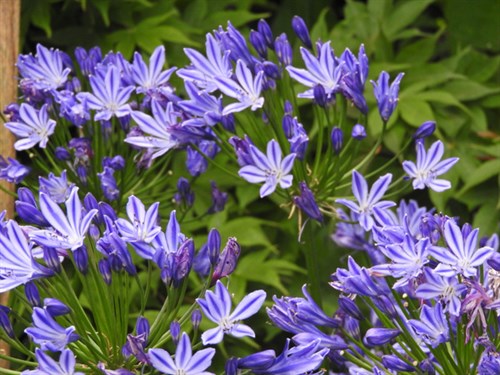
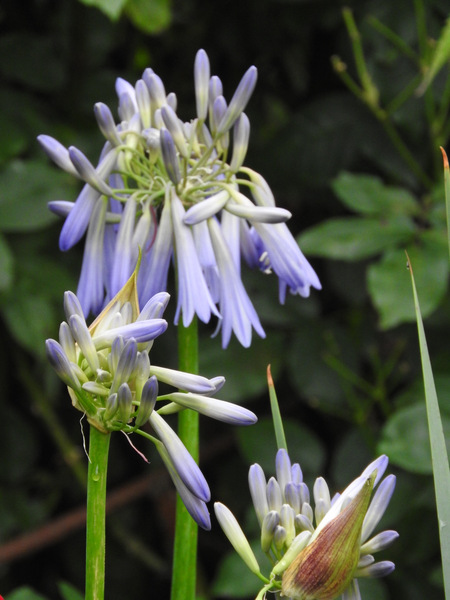
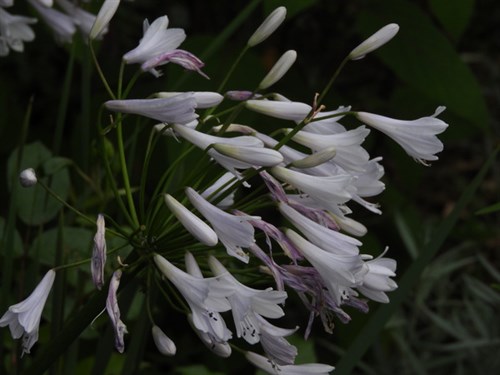
Sky rockets by night - kniphofia uvaria nobilis 7
feet tall
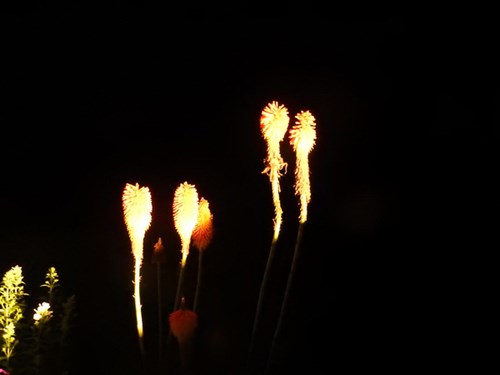
Crocosmia masonoria blending beautifully with euphorbia
donii "Amjilassa" from the Himalayas and geranium "Roxanne" whose
provenance is the subject of some debate!
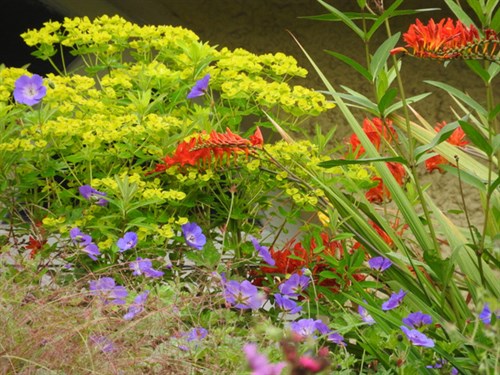
The Far East
Cautleya spicata, a member of the ginger family which is
very happy in moist shade which is why it does so well
here
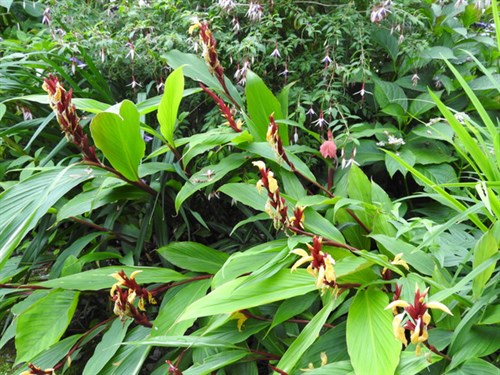
In the same family from particularly areas
bordering the Himalayas, is the genus roscoea, represented
here by cultivars "Red Gurkha" and "Dalai Lama".

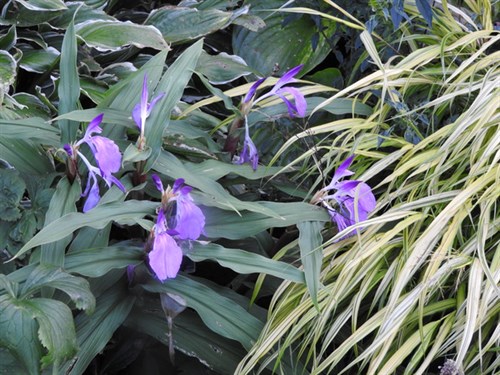
The wonderful flowers of hosta plantaginea are the
best in the genus,
3-4" long and highly scented. Needs warm weather to flower well
which is why this plants stays in the large tunnel year round. It
had quite a journey to get to us from a garden in Italy, a kind
gift from friends Olga and Allan. It was division from a plant in
Olga's mothers garden and is a much treasured plant.
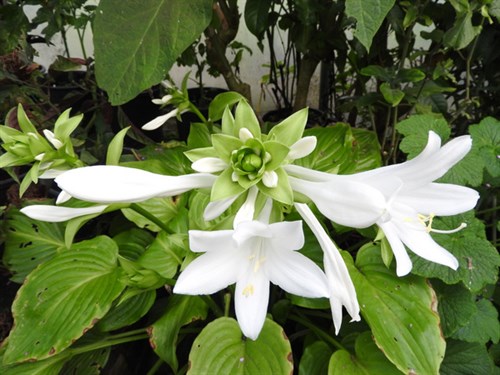
Lilium "Miss Feya" a cultivar in the Tree Lily
section

South America
Salvias come mostly from Central America and are
stalwarts of late summer/autumn borders but are slow this
year
S. involucrata bethellii long established here and very
hardy.

Probably the most popular at the moment is s. "Amistad",
tall and imposing and up to 4 feet tall
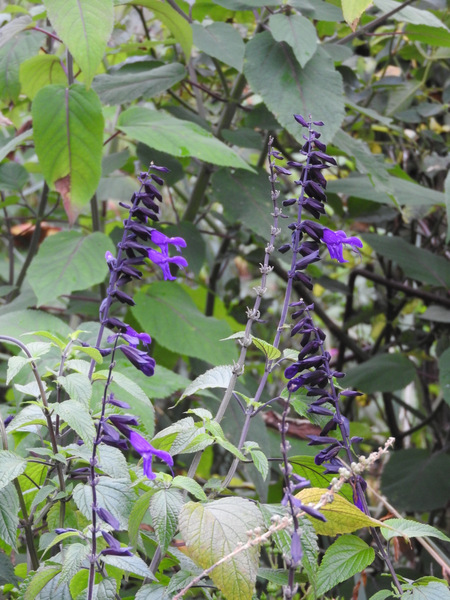
"Dysons Joy" bred at Great Comp (see below) by
William Dyson a world authority on Salvias

Lobelia tupa from Chile is not considered totally hardy
but it has survived here in very well drained soil and a sheltered
position for 12 years and made a huge clump.

Alstroemerias are endemic to S. America but this
is a recent cultivar. "Indian Summer" may be something of a
misnomer but is a fine plant with very dark leaves and intensely
vibrant flowers. Long flowering from July until
September.
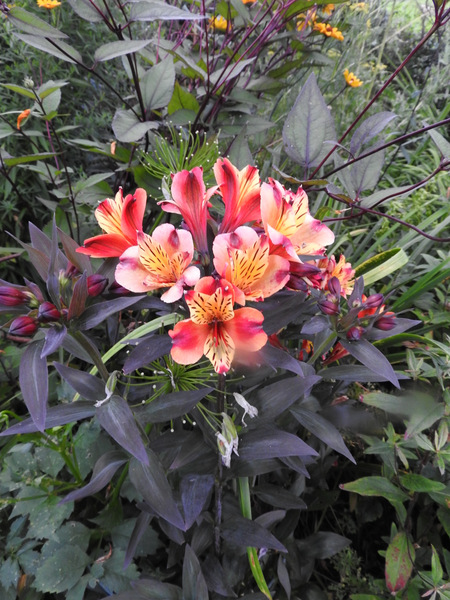
Back in Wales this fine study in shades of blue includes
thalictrums, hydrangea aspera "Macrophylla" and the long flowering
veronicastrum virginicum "Album"
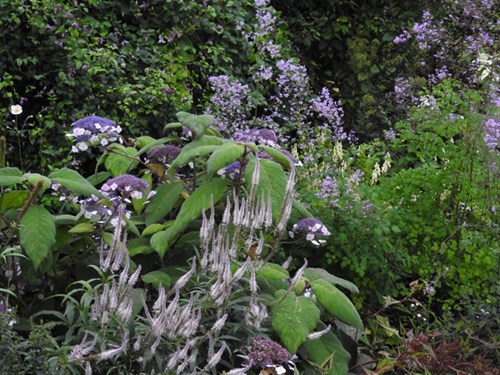
Hydrangea paniculata "Vanille Fraise", a
fine unknown phlox and echinops bannaticus.
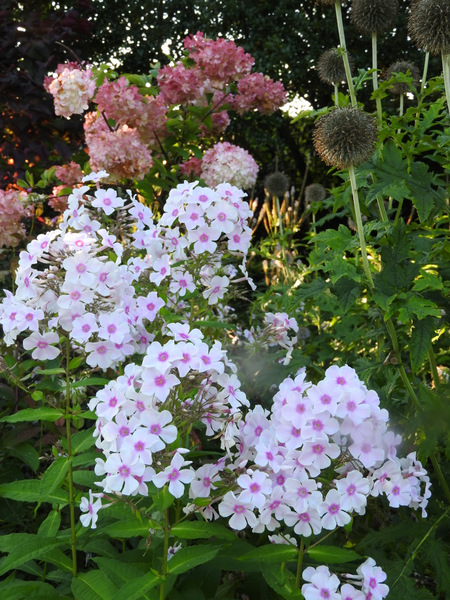
A mixed collection of some of the 80+ hydrangeas at
Cilgwyn Lodge
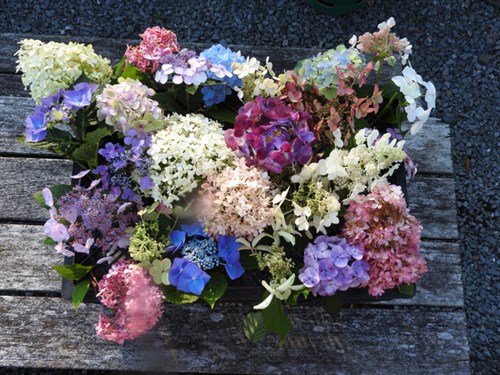
Wildlife and countryside
A continual theme of this summer has been the absence of winged
insects in particular wasps, butterflies and dragonflies. A
beekeeper who has hives just a few yards down the lane from us
laments the lack of honey this year and has had major problems with
his bees swarming.
Only cabbage white butterflies have put in an appearance over
the last few weeks, other than that just a few Peacocks and Red
Admirals. However the insects I miss the most are the large
dragonflies like the Emperor which have attitude and
fly straight at you with that clattering menace of their
large wings. No threat to us of course but any other flying insect
is hunted down and the aerial combats are a joy to behold and the
hunted does not always come off second best!
Peacock butterfly on phlox a favorite with
butterlies and a litmus test of how many there are.
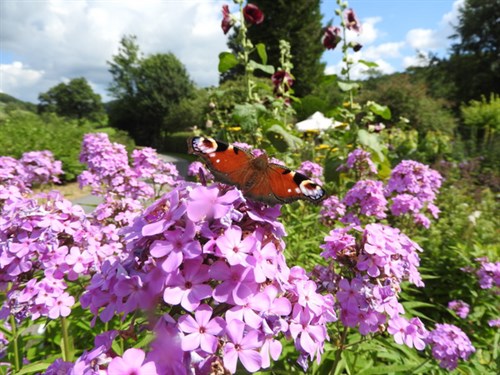
Two young hedgehogs were welcome visitors in the nursery
area and readily took the dried catfood we put down for them. It is
said that if you see a hedgehog in the daytime there is something
wrong with them and sadly that proved to be correct as we
later found one of them dead in the garden.
I wrote last year about the first signs of ash dieback
here and this summer it is more advanced with entire branches
defoliated on many trees and in some cases the whole tree. It seems
to be evident across a wide age range.
To end on a brighter note there are Kingfishers in
abundance and along the stream plenty of Dippers. However we no
longer see the Heron on the Paddock pond which is a relief.
Visits
A long weekend away at the beginning of August to the
balmy South East was the highlight of the month. We visited 3
gardens: Lullingstone Castle www.lullingstonecastle.co.uk and
Great Comp www.greatcompgarden.co.uk near
Sevenoaks in Kent and RHS Hyde Hall near Chelmsford in Essex
www.rhs.org.uk/gardens/hyde-hall
across the dreaded Dartford Crossing on the M25 - delays of 90
minutes are commonplace!! More details about each of them can
be found on their websites.
The main reason of the trip was a return visit to
Lullingstone and Tom Hart- Dyke who has become a good friend since
we first met him in 2009. This for us was the
best part of the weekend.

The World Garden which is the centrepiece, has grown
enormously and Tom had added new polytunnels to house his large
collections of cacti, orchids and many other tender and unusual
plants.

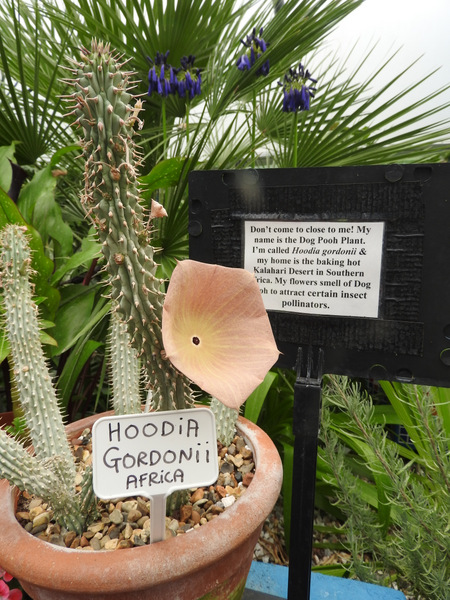
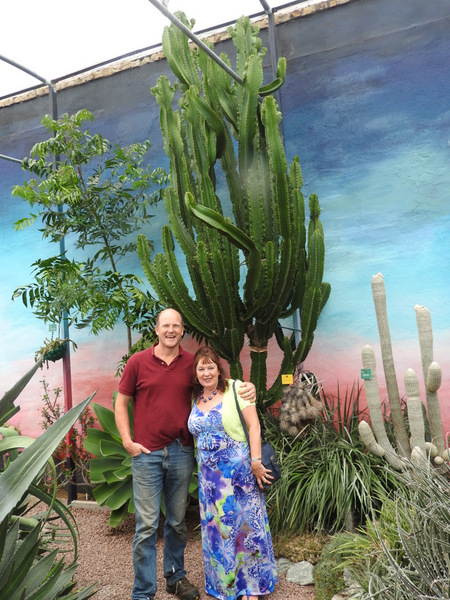

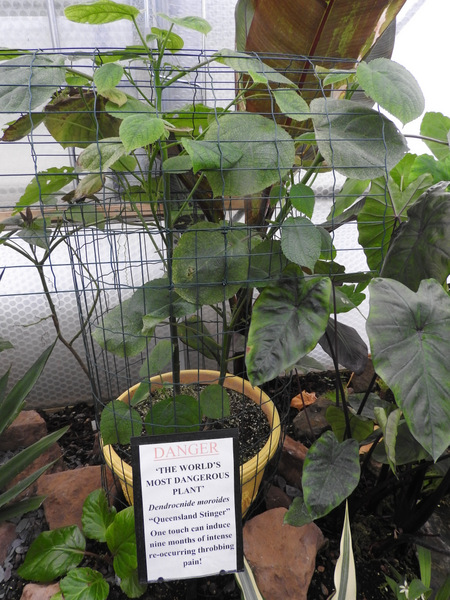
This remarkable likeness of a baobab tree in the
African garden is manufactured from coils of steel wire and highly
effeective
Another high quality sculpture in steel

It was good to see plants we had supplied to him doing so
well in the tunnels and outside. It is a fabulous plants persons
destination with a passionate and highly knowledgeable
horticulturist at the helm, which shines through in the
imaginative planting and artefacts skillfully placed around the
gardens.
The 15thC gate house which is Tom's home. The castle no
longer exists but there is a fine Georgian mansion in it's
place
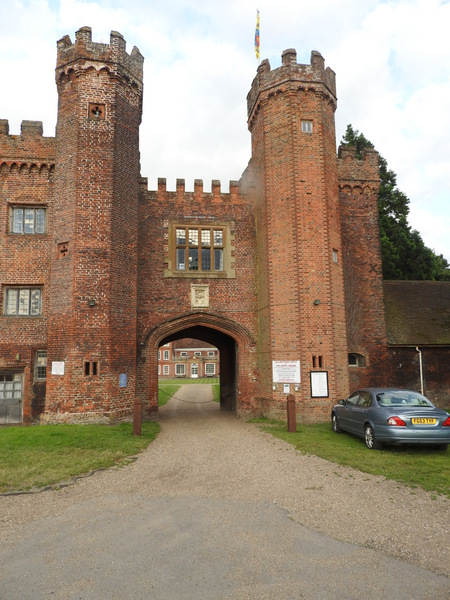
Tom's living room is comfortable and relaxing and
is watched over by a portrait (which appears to sit on Tom's
shoulder!!) allegedly of Queen Anne who visited Lullingstone during
her rein.

Tom is the very best of company and it was good to meet
his multi talented girlfriend Camilla who is a producer of TV
garden programmes. As you can imagine we had an interesting
discussion about the coverage of gardening on TV!!
RHS Hyde Hall was a complete contrast and quite
alien to us as the garden is set in one of the
driest parts of the UK with less than 20 inches of rain (65-70
inches here!) and bitter easterly winds in the winter.
No hedges, fences or livestock just wide sky and miles
of arable land.
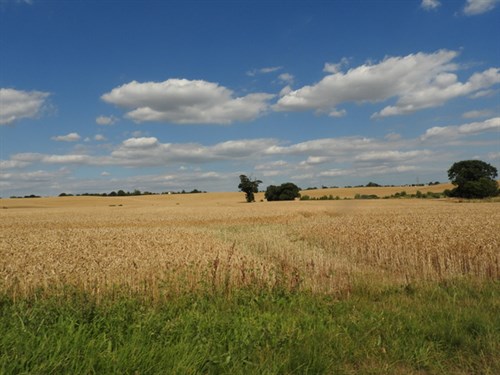
Many parts of the gardens were parched and much of the
planting for our tastes was unimaginative and repetitive,
perhaps reflecting the plant availability in such a
challenging location.



There was however that weekend a Flower Festival with many
good nurseries, sundries and food stalls. One thing which struck us
most forcibly was the large number of younger people in attendance,
buying plants and evidently keen gardeners - hope for the
future!
Great Comp is a mature and much loved private garden set
around an old house. Like many long established gardens it is
relaxed and comfortable, has some great planting and one thing we
always look for is a natural flow so that you never retrace your
steps - quite a feat in a large garden. It has a large collection
of salvias some of which were for sale (sadly not as many varieties
as I would have liked) but some good plantings of them in the
gardens which do well there in the warm climate.

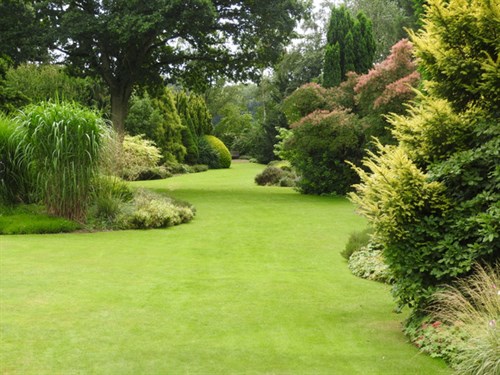


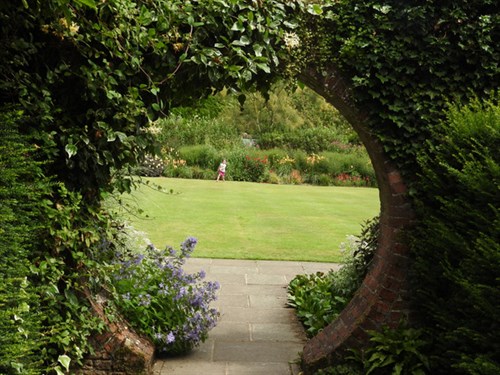
And now the answer to the question I asked
at the beginning. It's the shadow of a BFG of course. A Big
Friendly Gardener!!

A prize for you if you got it right - a big bunch
of the stars of the month!

And if you didn't get the answer right, as a
consolation prize, a small posy of alstroemeria, dicliptera sericea
and dhalias.
